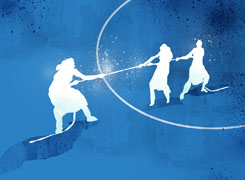Sir i am 41 years old. Time horizon is 20 years. I have parag parikh flexicap, hdfc flexicap, franklin india flexicap, canara robeco flexicap, sbi long term equity fund. I am investing 2000 rupees in each of these funds. Do i need to add or remove funds to have the right mix of value, growth and momentum and to reduce overlap. I like multicap category too. Do i need any fund from that category too. Sir Kindly suggest the funds i need to add or remove. I am still in the beginning phase of my investment. I can make changes.
Ans: You are investing Rs 2000 each in five different equity mutual funds: Parag Parikh Flexicap, HDFC Flexicap, Franklin India Flexicap, Canara Robeco Flexicap, and SBI Long Term Equity Fund. All of these are primarily flexicap funds except the SBI Long Term Equity Fund, which is an ELSS (Equity Linked Savings Scheme). Having flexicap funds in your portfolio provides diversification as they invest across market capitalizations.
The portfolio’s tilt toward flexicap funds is generally good for the long term, especially for a 20-year investment horizon. However, there may be some overlap in the holdings, given that all the flexicap funds invest in the same market segments. Let’s assess it from three perspectives:
Portfolio Overlap
Style Mix (Value, Growth, Momentum)
Diversification through Multicap Funds
Let’s break it down to see how you can refine your portfolio.
Portfolio Overlap Evaluation
Investing in multiple flexicap funds can sometimes lead to unnecessary overlap. While flexicap funds have flexibility across large, mid, and small-cap stocks, fund managers in different funds may hold similar top stocks. This overlap can lead to a situation where your funds are not providing true diversification, despite the number of schemes.
Top Holdings Overlap: Many flexicap funds tend to hold the same top large-cap stocks. This reduces the diversification effect.
Sector Exposure: You might end up being overexposed to certain sectors like banking, IT, or FMCG, which could lead to sector concentration risks.
Reduced Efficiency: Having multiple flexicap funds means paying expense ratios for all of them, despite many of them investing in similar stocks.
To address this, reducing the number of flexicap funds might be wise. You could consider keeping only 1-2 flexicap funds with a strong track record. This would reduce overlap and make your portfolio more efficient.
Balancing Value, Growth, and Momentum
Achieving the right mix between value, growth, and momentum is essential for a well-rounded portfolio. Here's how your current funds stand:
Flexicap Funds: These funds generally provide a mix of value and growth. They are not focused on one particular style.
ELSS Fund (SBI Long Term Equity Fund): This is a tax-saving fund that also follows a flexicap strategy. It typically has a long-term growth orientation.
Currently, your portfolio seems to be growth-oriented, as flexicap funds often lean toward growth stocks that have strong future potential. However, to add more balance:
Value Funds: You might consider adding a value-oriented fund to your portfolio to add the "value" component, as value funds invest in stocks that are undervalued but have strong fundamentals. This will help your portfolio balance out during market downturns.
Momentum Funds: If you are interested in momentum, you might explore funds that focus on stocks with high relative strength or price momentum. This can add a different dimension to your portfolio during bull markets.
Right now, you do not have a dedicated value or momentum fund. Adding a fund with a value focus or momentum strategy could enhance diversification.
Flexicap vs Multicap – Should You Add Multicap?
While flexicap funds offer flexibility across market capitalizations, multicap funds come with a mandate to invest in all three market caps – large, mid, and small, in a more structured way. This means multicap funds offer a more consistent allocation across market segments.
Advantages of Multicap Funds: Multicap funds maintain a more balanced allocation across large-cap, mid-cap, and small-cap stocks. This could give you more exposure to small- and mid-cap companies, which could generate higher returns in the long term.
Recommendation: Given that you are in the early phase of your investment and have a long horizon, adding one multicap fund to your portfolio could provide better diversification across market capitalizations. This can also reduce your portfolio’s dependence on large caps, which dominate most flexicap funds.
However, be cautious not to over-diversify. A portfolio of 4-5 funds is usually sufficient for most investors. Adding a multicap fund means you might want to reduce the number of flexicap funds.
ELSS and Tax Saving Fund Consideration
SBI Long Term Equity Fund, being an ELSS, serves a dual purpose. It helps you save taxes under Section 80C while offering equity exposure. However, ELSS funds also have a 3-year lock-in period.
If Tax Saving is Needed: If your goal is to continue saving taxes, you can retain this ELSS fund. However, if you have other tax-saving options and don’t need this, you may consider replacing it with a more suitable growth or value-oriented equity fund that doesn’t have a lock-in.
Should You Add or Remove Funds?
Considering your current investment and objectives, here are my suggestions:
Reduce the Number of Flexicap Funds: You can streamline your flexicap exposure by reducing the number of funds. Choose 1-2 funds that you believe are consistent performers with strong management.
Add a Multicap Fund: A multicap fund will diversify your portfolio further by ensuring exposure across all market caps. This will complement your flexicap exposure.
Consider Adding a Value Fund: To balance the growth focus of your portfolio, you could introduce a value-oriented fund. This would provide stability during market downturns when growth stocks may underperform.
Review ELSS Based on Tax Needs: If you no longer need tax-saving benefits, consider whether an ELSS is necessary. You could replace it with a more growth or value-focused fund.
Advantages of Actively Managed Funds Over Index Funds
It’s worth noting that actively managed funds, especially flexicap and multicap funds, offer several advantages over index funds:
Active Stock Selection: Actively managed funds can pick stocks based on future growth potential and valuations. Index funds simply mirror the index, regardless of stock performance.
Downside Protection: Active funds have the flexibility to shift allocations during market corrections. Index funds do not offer this flexibility.
Outperformance Potential: In the long term, actively managed funds with skilled managers can outperform their benchmark index. Index funds can only match the market, not beat it.
This is why actively managed funds in your portfolio, especially with a certified financial planner’s guidance, could offer better returns over time.
Disadvantages of Direct Funds and Benefits of Regular Funds
You may hear about direct funds as a lower-cost option. However, regular funds that you invest in through a Certified Financial Planner have distinct advantages:
Expert Guidance: Investing through a Certified Financial Planner ensures that your portfolio is monitored regularly, adjusted for market conditions, and optimized for your long-term goals.
Lesser Hassle: With direct funds, you are responsible for all decisions, including rebalancing, fund selection, and ongoing reviews. With regular funds through an expert, this burden is lifted.
Final Insights
At this stage, you are on the right track by focusing on equity mutual funds with a long-term horizon. Your portfolio can benefit from small adjustments:
Reduce the number of flexicap funds to avoid overlap.
Add a multicap fund to ensure consistent exposure across all market caps.
Consider adding a value fund to balance your portfolio with a value-growth mix.
Review the need for ELSS based on your tax-saving requirements.
Continue with regular funds for expert guidance and better decision-making.
By making these changes, your portfolio will be more diversified, aligned with your risk tolerance, and set for long-term growth.
Best Regards,
K. Ramalingam, MBA, CFP,
Chief Financial Planner,
www.holisticinvestment.in
https://www.youtube.com/@HolisticInvestment











.jpg)














